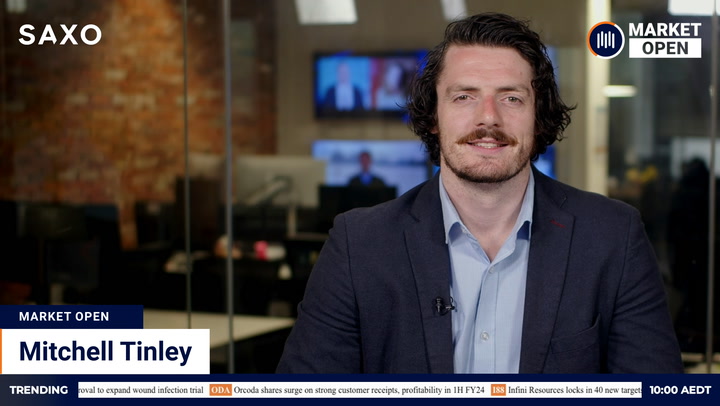Aussie shares were set to open lower following heavy selling on Wall Street as stubbornly strong US jobs data bolstered the case for significantly higher interest rates.
The S&P/ASX 200 was poised to shed 61 points or 0.9 per cent, according to futures action. The Australian benchmark fell 0.8 per cent on Friday, paring strong gains through the middle of the week.
On Friday, oil continued a breakneck rally that lifted the international benchmark 15 per cent last week. Spot iron ore prices inched higher. Most metals booked solid losses.
The dollar tested two-and-a-half-year lows in the wake of the Reserve Bank’s decision to tap the brakes on rate hikes.
Wall Street
US stocks trimmed a winning week after unemployment unexpectedly fell, signalling the Federal Reserve has work to do to slow a post-pandemic economic rebound that lifted inflation to 48-year highs.
The S&P 500 sank 105 points or 2.8 per cent at the end of a week of wild swings in equities and other risk assets. The Dow Jones Industrial Average skidded 630 points or 2.11 per cent. The Nasdaq Composite shed 421 points or 3.8 per cent.
The US jobless rate dropped to 3.5 per cent last month from 3.7 per cent in August as the economy added 263,000 jobs. Economists polled by Reuters had expected a more modest increase of 250,000 new hires.
The report continued a run of strong economic data that maintains pressure on the Fed to keep increasing rates until inflation recedes. Investors fear the current aggressive pace of increases puts the US economy on collision course with a recession.
“The current data means that the Fed has pretty much a free hand to hike the rate and they know that the Fed can tolerate recession but not high inflation numbers, and this means more aggressive rate hikes,” Naeem Aslam, chief market analyst at AvaTrade, said.
The reaction to the report undermined a strong week for equities. The major indices broke three-week losing streaks.
The Dow trimmed its advance for the week to 2 per cent. The S&P 500 and Nasdaq Composite gained 1.5 and 0.7 per cent, respectively. The tech index closed less than 1 per cent above this year’s low.
“This was a classic case of good news is bad news,” Bill Sterling, strategist at GW&K Investment Management, told Reuters. “The market took the good news of the robust labor market report and turned it into an ever-more vigilant Fed and therefore potentially higher risks of a recession next year.”
Chip stocks tumbled following a profit warning from Advanced Micro Devices. AMD said demand for PCs weakened significantly last quarter.
The Philadelphia SE Semiconductor index dived 6.06 per cent. AMD gave up 13.87 per cent.
Australian outlook
Friday’s softness looks likely to extend into the new week as traders book profits from last week’s fierce bear market rally. The S&P/ASX 200 had its best week in two years after the RBA became the first major central bank to slow the pace of rate increases.
The rates news has handed the ASX a handy cushion after retesting support near two-year lows earlier in the week. No such joy for the dollar, which on Friday fell as low as 63.54 US cents, a level last seen in April 2020 during the initial pandemic crash in risk assets. The Aussie was this morning trading at 63.71 cents, broadly steady after the weekend.
Dollar weakness is a plus for exporters, a negative for importers and consumers paying for international products and services. Australia’s export-driven economy generally welcomes a weaker currency. Demand for raw materials is boosted by cheaper prices. Retailers selling imported goods are obvious losers.
All 11 US sectors sank on Friday. Energy was the best of the bunch with a loss of 0.72 per cent, falling even as crude prices rose for a fifth night (more below).
Surging bond yields smashed the three sectors dominated by rate-sensitive Big Tech. Technology fell 4.14 per cent, consumer discretionary 3.54 per cent and communication services 2.84 per cent. The twin engines of the ASX 200, materials and financials, lost 2.54 and 2.34 per cent, respectively.
Inflation is back front and centre in the US this week as a jittery market once again seeks evidence rate rises are having an impact. Wholesale inflation figures on Wednesday night may offer a hint of what awaits when September consumer prices are released the following night.
Retail sales data on Friday night will affect how the week winds up. A “hot” result in any of these reports would increase pressure on the Fed to keep hiking.
The domestic economic calendar looks light. The Australian Industry Group releases a services-sector survey this morning. Reports on business and consumer confidence follow tomorrow.
The annual general meeting season is getting underway. This week brings meetings for shareholders in Telstra and Bailador Technology Investments (Tuesday); Commonwealth Bank and CSL (Wednesday); and Aurizon, Mirrabooka and Djerriwarrh (Thursday).
Bank of Queensland reports full-year earnings on Wednesday.
IPOs: the only potential listing this week, according to the ASX, is rare earths explorer Bubalus Resources on Thursday.
Commodities
Oil rose for a fifth session, extending its rally for the week to 15 per cent. The explosive move followed a decision by the Organization of the Petroleum Exporting Countries and allies to lower production targets by two million barrels a day from next month.
Brent crude settled US$3.50 or 3.7 per cent higher at US$97.92 a barrel. The US benchmark, West Texas Intermediate, climbed 4.7 per cent to US$92.64. For the week, WTI gained 16.5 per cent.
Copper fell for a third session after Fed officials reasserted their determination to crush inflation. Benchmark copper on the London Metal Exchange dropped 1.9 per cent to US$7,507.75 a tonne.
“Everything is slowing. There’s no doubt the impact higher interest rates is likely to have. We’re hearing about companies putting on hiring freezes now,” John Meyer, head of research at SP Angel, told Reuters.
Aluminium declined 1.8 per cent, nickel 1.3 per cent, zinc 4.2 per cent and tin 3.6 per cent. Lead bucked the trend with a rise of 1.7 per cent. Lead, aluminium and nickel were the week’s best performers gaining between 6.4 and 10.7 per cent.
Spot iron ore prices inched higher amid speculation the Chinese government might use this month’s Communist Party congress to relax its hardline position on Covid-19. The spot price for ore landed in China rose 16 US cents or 0.2 per cent to US$95.62 a tonne.
BHP‘s US-traded depositary receipts fell 0.76 per cent. Earlier, the miner’s UK listing improved 0.41 per cent. Rio Tinto tacked on 0.23 per cent in the US and 0.12 per cent in the UK.
US gold miners fell sharply as the September jobs report boosted alternative stores of wealth that compete with precious metals for investment flows. The NYSE Arca Gold Bugs Index slumped 4.62 per cent after gold for December delivery settled US$11.50 or 0.7 per cent lower at US$1,709.30 an ounce.





